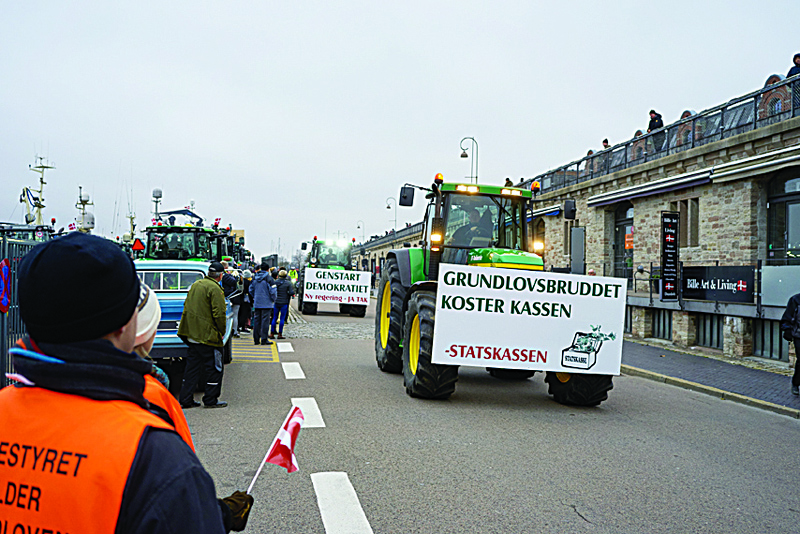
COPENHAGEN, Denmark: Denmark's mink farmers are mourning what they say is the death of their industry after a government order to cull all of their stocks over a mutated variant of the new coronavirus. On Saturday, angry farmers and supporters plan to demonstrate against the cull in the country's two biggest cities, Copenhagen and Aarhus, with 400 tractors expected to roll in.
"We're in shock," Marianne Norgaard Sorensen tells AFP. "Words can't describe the nightmare we've been through." She and her husband, who has been a mink farmer since 1993, live in North Jutland, the region in northwestern Denmark home to the most mink farms. Like millions of others across the country, their 27,000 minks were slaughtered in early November and around two thirds of the country's stocks have been culled to date.
"We wrote to the veterinary authorities to ask for two more days but then they came … and took over. It was very harsh, video of the slaughter went online," she recalls. "If we had only had two more days, we would have done it in a more humane way." Meanwhile, hundreds of Danish farmers and mink breeders demonstrated with tractors Saturday against a government decision to cull their minks to halt the spread of a coronavirus variant. More than 500 tractors, many decked out with the Danish flag, drove past the government's offices and parliament in Copenhagen to the port. Another 400 staged a similar protest in the country's second city, Aarhus.
Prime Minister Frederiksen's government has acknowledged that its decision to cull more than 15 million minks had no legal basis for those not contaminated by the COVID-19 variant, infuriating breeders. Denmark, a country of around 5.8 million people, has been the world's leading exporter of mink fur for several decades. It sells pelts for around 670 million euros ($792 million) annually, and is the second-biggest producer worldwide, behind China.
Political fiasco
Denmark's mink breeding began in the 1930s, when farmers sought to diversify their business as butter and meat prices tumbled. Boosted by a favorable climate, the sector peaked in the 1960s, when there were some 6,000 farms compared to around 1,000 today.
With three times more minks than people, Denmark is now the world's biggest exporter of pelts, ringing up sales of 670 million euros ($792 million) annually, and the second-biggest producer behind China. The animal is prized for its soft fur, used in the fashion industry for coats, collars and hats. Wearing fur remains especially popular in China, while attitudes have shifted in the West over the years.
But minks have posed a problem in the fight against the new coronavirus. The animals can catch the virus, and also pass it back to humans. In early November, the Danish government sounded the alarm when it announced a nationwide cull of its 15 to 17 million minks, saying they could carry a mutated variant of the virus that could render any future vaccine for humans less effective.
The strain, dubbed 'Cluster 5', was detected in 12 people in August and September in North Jutland, and the government swiftly imposed strict restrictions on the region. Since then, no new cases of the strain have been detected in humans or minks, the health ministry said Thursday, saying it has "most likely been eradicated". The cull has turned into a fiasco for the government.
It was forced to admit last week that it had no legal power to order the killing of healthy minks outside the contaminated zones, leading to the resignation on Wednesday of the agriculture minister and dealing a blow to public confidence in the government. Prime Minister Mette Frederiksen has nonetheless insisted the cull is "non-negotiable", and her government is now preparing legislation to make it possible-by banning mink farming until January 1, 2022.
No hope for recovery
Meanwhile, in another part of Jutland, Erik Vammen has held off killing his animals so far, even though that means he forgoes the extra compensation paid to those who cull rapidly. "At night when I see the lights of a car I'm afraid it's the police," admits this 60-something who inherited his mink farm from his father and grandfather before him.
Since neither his nor the neighboring farms have had any cases of coronavirus, his minks are not a priority. But he knows that "if I don't kill the minks they'll come and kill them." He says the state's financial compensation is not enough to make up for his lost livelihood. And, he argues, how can you have confidence in authorities who impose measures without any legal basis? Few believe the industry will ever recover, even if mink farms are authorized to open again in 2022. Most agree it would take more than 10 years to cultivate minks with top quality pelts. - AFP









